lock Alfa Romeo 156 2004 Owner handbook (in English)
[x] Cancel search | Manufacturer: ALFA ROMEO, Model Year: 2004, Model line: 156, Model: Alfa Romeo 156 2004Pages: 357, PDF Size: 5.04 MB
Page 156 of 357

GETTING TO KNOW YOUR CAR
154
R - Reverse
Move the gearshift lever to Rwith the car
stationary, the engine idling and the brake
pedal pressed.
To prevent accidental engagements, mov-
ing the lever to this position is only allowed
raising the ring (A-fig. 138) placed un-
der the gearshift lever knob.
With the lever in position R the reversing
lights turn on and a beep is sounded for
safety reasons to indicate that reverse gear
has been engaged.
Before moving the lever, press the brake
pedal: the car must be stationary.
WARNINGWith the lever in position R,
reverse gear is not engaged if the vehicle
speed is above the established level. When
the car speed falls below this level, reverse
gear is engaged and remains engaged even
if the speed returns above the limit.
AUTOMATIC OPERATIONSelector lever
For automatic gearshifting, move the
gearshift lever to the right sector
(fig. 138) in one of the following posi-
tions:
P- park (the engine can be started)
R- reverse
N- neutral (the engine can be started)
D- automatic forward gear.
Raise the ring (A-fig. 138) placed un-
der the gearshift lever knob for shifting:
– from Pto Rand vice versa
– from Nto R.P - Park
To prevent accidental engagements, mov-
ing the lever to position Pis only allowed
raising the ring (A-fig. 138) placed un-
der the gearshift lever knob.
When the car is being parked, move the
lever to this position. A device in the gear-
box will lock the driving wheels.fig. 138
A0B0265m
Always pull the hand-
brake completely before
leaving the car.
Move the gearshift lever to posi-
tion P when getting out of the car
leaving the engine running.
WARNING
Page 161 of 357
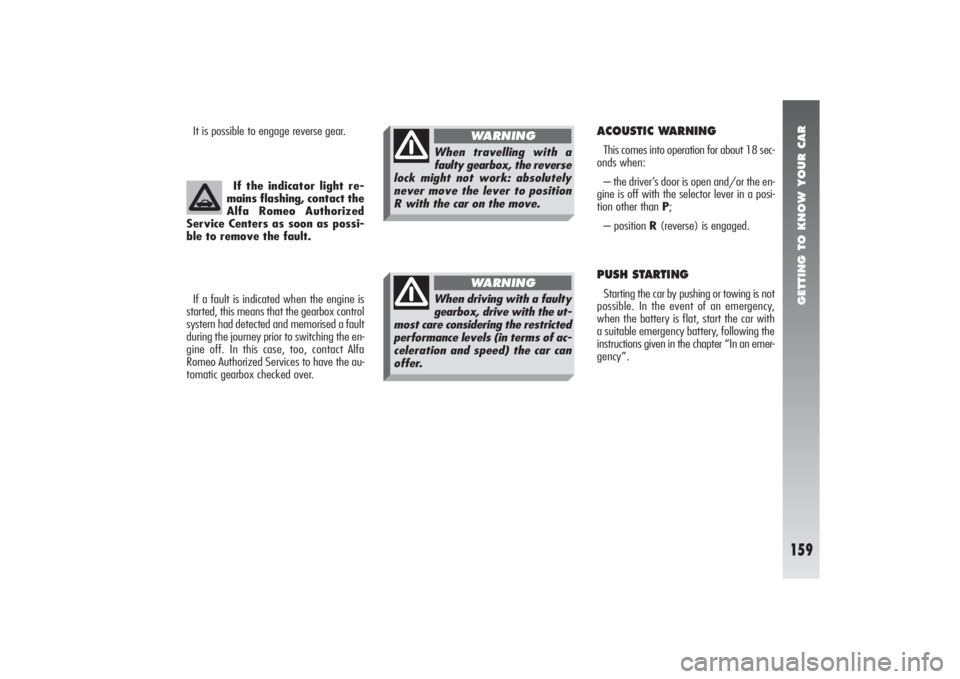
GETTING TO KNOW YOUR CAR
159
If the indicator light re-
mains flashing, contact the
Alfa Romeo Authorized
Service Centers as soon as possi-
ble to remove the fault.
If a fault is indicated when the engine is
started, this means that the gearbox control
system had detected and memorised a fault
during the journey prior to switching the en-
gine off. In this case, too, contact Alfa
Romeo Authorized Services to have the au-
tomatic gearbox checked over.It is possible to engage reverse gear.
ACOUSTIC WARNINGThis comes into operation for about 18 sec-
onds when:
– the driver’s door is open and/or the en-
gine is off with the selector lever in a posi-
tion other than P;
– position R(reverse) is engaged.PUSH STARTINGStarting the car by pushing or towing is not
possible. In the event of an emergency,
when the battery is flat, start the car with
a suitable emergency battery, following the
instructions given in the chapter “In an emer-
gency”.
When driving with a faulty
gearbox, drive with the ut-
most care considering the restricted
performance levels (in terms of ac-
celeration and speed) the car can
offer.
WARNING
When travelling with a
faulty gearbox, the reverse
lock might not work: absolutely
never move the lever to position
R with the car on the move.
WARNING
Page 163 of 357

GETTING TO KNOW YOUR CAR
161
INTERNAL FITTINGSGLOVEBOX On the dashboard there is a key glovebox
with light.The compartment is lit by a courtesy light
when it is open (when the ignition key is
at MAR(B-fig. 143).
There is a recess on the lid (C-fig. 143)
for inserting a pen or pencil. For the versions
/ markets where provided, the closure flap
is fitted with a lock. The lock can be
opened/closed using the ignition key.
GRAB HANDLES
(fig. 144)
Grab handles are set above the front doors.
Two grab handles (A) fitted with a coat
hook (B) are located above the rear doors.
fig. 142
A0B0587m
fig. 144
A0B0124m
fig. 143
A0B0261m
To open the glovebox use lever (A-
fig. 142).
Do not travel with the
glovebox open; it could
harm the passenger in the event of
an accident.
WARNING
Page 164 of 357

GETTING TO KNOW YOUR CAR
162
CEILING LIGHTS The car is fitted with passenger’s com-
partment ceiling lights (front/rear) with
gradual switching on/off. Timings, defined
as max. switching on time elapsing between
the end of gradual switching on and the start
of gradual switching off are as follows:
1)approx. 6 seconds when:
– unlocking the doors manually or by the
remote control
– closing the driver’s door to get into the
car and fit the key into the ignition switch
– removing the key from the ignition
switch.
2)approx. 3 minutes from the door open-
ing.WARNING With ignition key at STOP
or when opening a door or the tailgate 15
minutes timing is activated, then ceiling
lights go off. Timing restarts each time a
door/tailgate is opened.
Front roof light (fig. 145)
The roof light comprises two lights with the
control switch.
With switch (A) in the central position
(1), both lights turn on when a door is
opened.
When the doors are closed, a timer is ac-
tivated for about 7 seconds, to allow the car
to be started. The lights go out when the ig-
nition key is turned to MAR(with the doors
closed).
Moving switch (A) to the left (position 0),
the lights stay off (position OFF).Moving switch (A) to the right (posi-
tion2) both lights stay on.
The spot function is operated by switch
(B).
Moving switch (B) to the left (position 1)
the left spot light turns on. Moving switch
to the right (position 2) the right spot light
turns on.
With switch (B) in the central position (po-
sition 0) the spotlights stay off.
WARNINGBefore leaving the car, make
sure that both switches are in the central po-
sition. This way, the roof lights will go out
when the doors are closed. If a door is left
open, the lights will go out automatically af-
ter a few seconds.
To turn them on again, simply open an-
other door or close the same one and open
it again.fig. 145
A0B0575m
Page 171 of 357
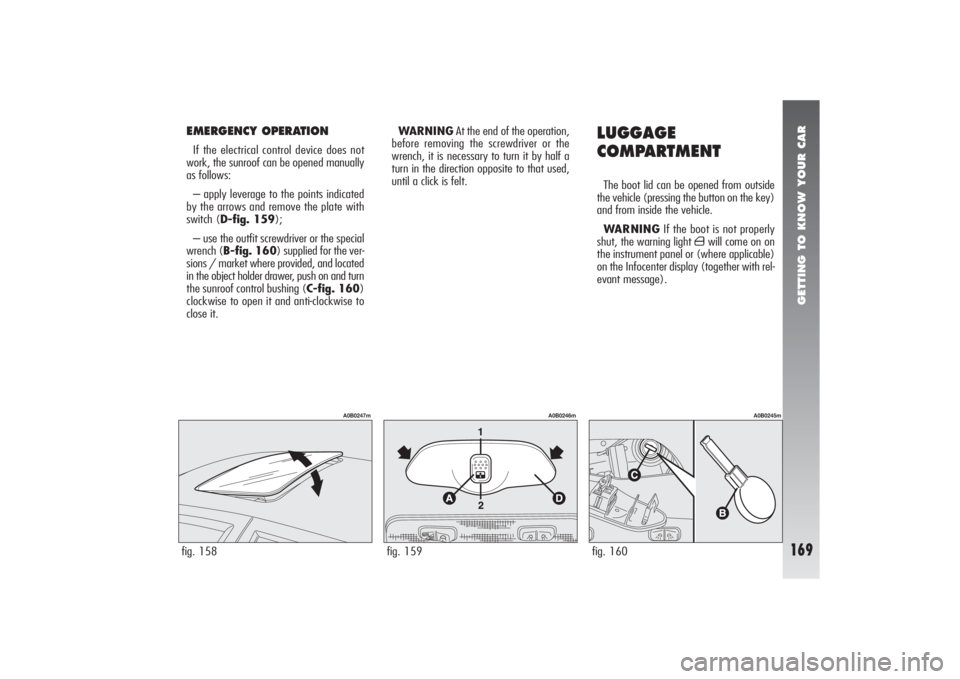
GETTING TO KNOW YOUR CAR
169
fig. 158
A0B0247m
EMERGENCY OPERATIONIf the electrical control device does not
work, the sunroof can be opened manually
as follows:
– apply leverage to the points indicated
by the arrows and remove the plate with
switch (D-fig. 159);
– use the outfit screwdriver or the special
wrench (B-fig. 160) supplied for the ver-
sions / market where provided, and located
in the object holder drawer, push on and turn
the sunroof control bushing (C-fig. 160)
clockwise to open it and anti-clockwise to
close it. WARNINGAt the end of the operation,
before removing the screwdriver or the
wrench, it is necessary to turn it by half a
turn in the direction opposite to that used,
until a click is felt.
LUGGAGE
COMPARTMENTThe boot lid can be opened from outside
the vehicle (pressing the button on the key)
and from inside the vehicle.
WARNINGIf the boot is not properly
shut, the warning light
´
will come on on
the instrument panel or (where applicable)
on the Infocenter display (together with rel-
evant message).
fig. 159
A0B0246m
fig. 160
A0B0245m
Page 173 of 357

GETTING TO KNOW YOUR CAR
171
CLOSING THE BOOTTo close the boot, lower it and press down
above the locking mechanism until it is
heard to click into place.
BOOT LIGHTING
(fig. 163)
Opening the boot, the light (A) in the up-
per part of the boot turns on automatically.
The light goes out closing the boot or af-
ter a few minutes (about 15) if the boot is
left open. In this case, to turn it on again
close the boot, then open it again.
fig. 163
A0B0000m
fig. 165
A0B0243m
fig. 164
A0B0242m
SECURING THE LOAD(fig. 164-165)
The load carried may be blocked with
straps hooked to the special rings in the boot
corners.
The rings also serve to secure the luggage
retaining net (available upon request, for
versions/markets where applicable) c/o
Alfa Romeo Authorized Services.
Page 175 of 357
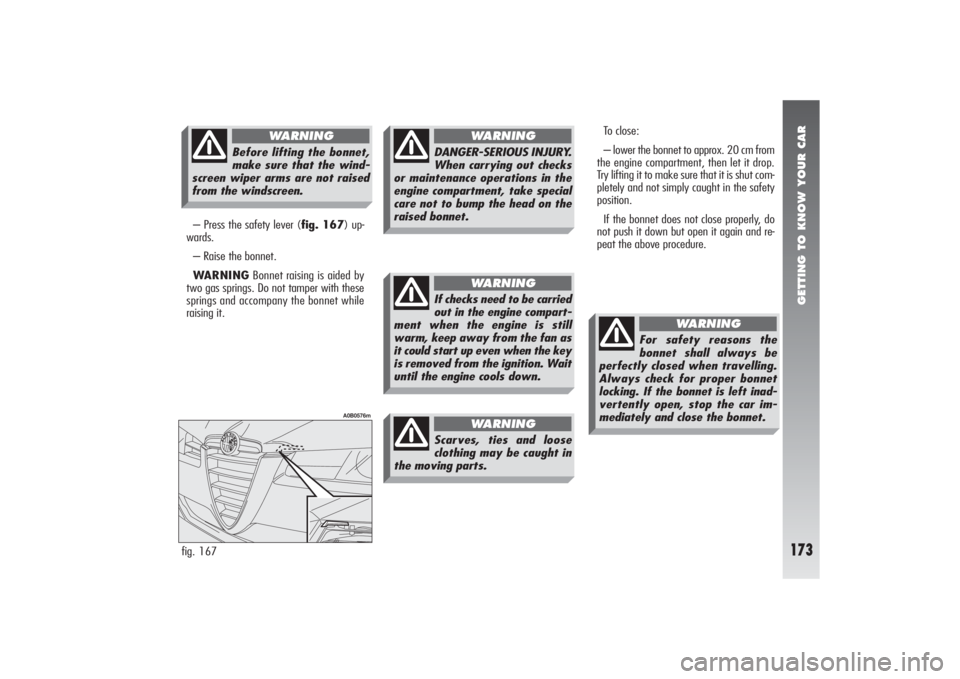
GETTING TO KNOW YOUR CAR
173
– Press the safety lever (fig. 167) up-
wards.
– Raise the bonnet.
WARNINGBonnet raising is aided by
two gas springs. Do not tamper with these
springs and accompany the bonnet while
raising it.
fig. 167
A0B0576m
Before lifting the bonnet,
make sure that the wind-
screen wiper arms are not raised
from the windscreen.
WARNING
DANGER-SERIOUS INJURY.
When carrying out checks
or maintenance operations in the
engine compartment, take special
care not to bump the head on the
raised bonnet.
WARNING
If checks need to be carried
out in the engine compart-
ment when the engine is still
warm, keep away from the fan as
it could start up even when the key
is removed from the ignition. Wait
until the engine cools down.
WARNING
Scarves, ties and loose
clothing may be caught in
the moving parts.
WARNING
To close:
– lower the bonnet to approx. 20 cm from
the engine compartment, then let it drop.
Try lifting it to make sure that it is shut com-
pletely and not simply caught in the safety
position.
If the bonnet does not close properly, do
not push it down but open it again and re-
peat the above procedure.
For safety reasons the
bonnet shall always be
perfectly closed when travelling.
Always check for proper bonnet
locking. If the bonnet is left inad-
vertently open, stop the car im-
mediately and close the bonnet.
WARNING
Page 179 of 357
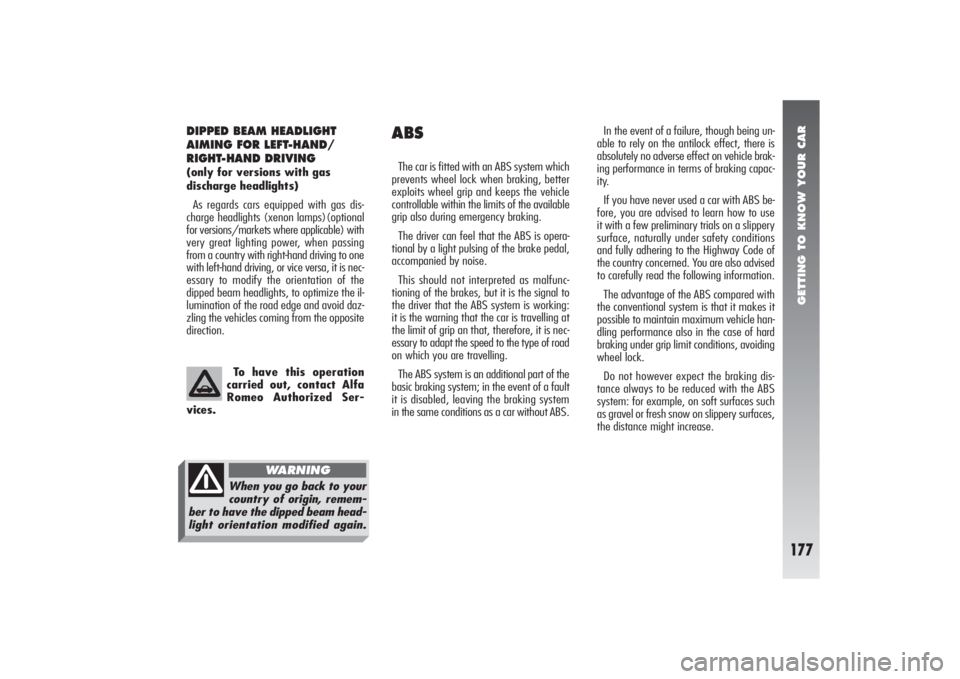
GETTING TO KNOW YOUR CAR
177
DIPPED BEAM HEADLIGHT
AIMING FOR LEFT-HAND/
RIGHT-HAND DRIVING(only for versions with gas
discharge headlights)
As regards cars equipped with gas dis-
charge headlights (xenon lamps)(optional
for versions/markets where applicable) with
very great lighting power, when passing
from a country with right-hand driving to one
with left-hand driving, or vice versa, it is nec-
essary to modify the orientation of the
dipped beam headlights, to optimize the il-
lumination of the road edge and avoid daz-
zling the vehicles coming from the opposite
direction.
To have this operation
carried out, contact Alfa
Romeo Authorized Ser-
vices.
When you go back to your
country of origin, remem-
ber to have the dipped beam head-
light orientation modified again.
WARNING
In the event of a failure, though being un-
able to rely on the antilock effect, there is
absolutely no adverse effect on vehicle brak-
ing performance in terms of braking capac-
ity.
If you have never used a car with ABS be-
fore, you are advised to learn how to use
it with a few preliminary trials on a slippery
surface, naturally under safety conditions
and fully adhering to the Highway Code of
the country concerned. You are also advised
to carefully read the following information.
The advantage of the ABS compared with
the conventional system is that it makes it
possible to maintain maximum vehicle han-
dling performance also in the case of hard
braking under grip limit conditions, avoiding
wheel lock.
Do not however expect the braking dis-
tance always to be reduced with the ABS
system: for example, on soft surfaces such
as gravel or fresh snow on slippery surfaces,
the distance might increase.
ABSThe car is fitted with an ABS system which
prevents wheel lock when braking, better
exploits wheel grip and keeps the vehicle
controllable within the limits of the available
grip also during emergency braking.
The driver can feel that the ABS is opera-
tional by a light pulsing of the brake pedal,
accompanied by noise.
This should not interpreted as malfunc-
tioning of the brakes, but it is the signal to
the driver that the ABS system is working:
it is the warning that the car is travelling at
the limit of grip an that, therefore, it is nec-
essary to adapt the speed to the type of road
on which you are travelling.
The ABS system is an additional part of the
basic braking system; in the event of a fault
it is disabled, leaving the braking system
in the same conditions as a car without ABS.
Page 180 of 357

GETTING TO KNOW YOUR CAR
178
Braking on corners always requires the ut-
most caution, even with the help of the ABS.
The most important piece of advice, how-
ever, is the following:Following these instructions you will be
in a condition to obtain peak braking per-
formance at all times.
WARNINGCars fitted with ABS must
only be fitted with wheel rims, tyres and
brake linings of the type and brand approved
by the Manufacturer.
The braking system is completed by the
electronic control braking distribution system
called EBD(Electronic Braking Force Dis-
tributor) which distributes the braking action
through the ABSsystem control unit and
sensors.
In the event of a system
fault, with lighting up of
the
>
warning light on the instru-
ment cluster (together with the
message + symbol shown by the
display), have the vehicle checked
immediately by Alfa Romeo Au-
thorized Services, driving slowly
to be able to regain full system
performance.
WARNING
When the ABS cuts in and
you feel the pedal pulse, do
not reduce the pressure, but keep
the brake pedal firmly pressed
with no fear; this way you will
stop in the shortest possible space,
compatibly with the conditions of
the road surface.
WARNING
The car is fitted with an
electronic brake distributor
(EBD). If the
>
and
x
warning
lights, where required, come on at
the same time (together with the
message + symbol shown by the
display) when the engine is run-
ning, there is an EBD system fault;
in this case, violent braking may
lock the rear wheels too early, with
the possibility of skidding. Drive
extremely carefully to the nearest
Alfa Romeo Authorized Services to
have the system checked over.
WARNING
In order to be able to exploit as far as pos-
sible the possibility of the antilock system
in the case of need, it is wise to follow a few
pieces of advice:
The ABS exploits the avail-
able grip in full, but it can-
not increase it; therefore, caution
is required on slippery surfaces,
without running unnecessary risks.
WARNING
If the ABS cuts in, it means
that the grip limit between
the tyres and the road surface has
been reached: it is necessary to
slow down and adapt driving to
the grip available.
WARNING
Page 181 of 357
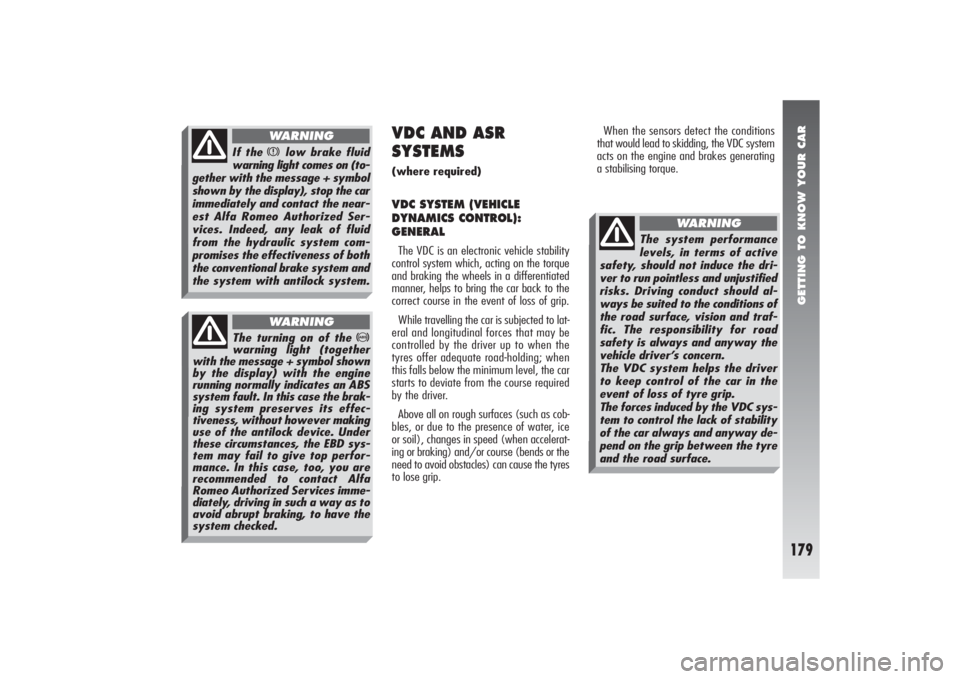
GETTING TO KNOW YOUR CAR
179
If the
x
low brake fluid
warning light comes on (to-
gether with the message + symbol
shown by the display), stop the car
immediately and contact the near-
est Alfa Romeo Authorized Ser-
vices. Indeed, any leak of fluid
from the hydraulic system com-
promises the effectiveness of both
the conventional brake system and
the system with antilock system.
WARNING
The turning on of the
>
warning light (together
with the message + symbol shown
by the display) with the engine
running normally indicates an ABS
system fault. In this case the brak-
ing system preserves its effec-
tiveness, without however making
use of the antilock device. Under
these circumstances, the EBD sys-
tem may fail to give top perfor-
mance. In this case, too, you are
recommended to contact Alfa
Romeo Authorized Services imme-
diately, driving in such a way as to
avoid abrupt braking, to have the
system checked.
WARNING
VDC AND ASR
SYSTEMS(where required)VDC SYSTEM (VEHICLE
DYNAMICS CONTROL):
GENERALThe VDC is an electronic vehicle stability
control system which, acting on the torque
and braking the wheels in a differentiated
manner, helps to bring the car back to the
correct course in the event of loss of grip.
While travelling the car is subjected to lat-
eral and longitudinal forces that may be
controlled by the driver up to when the
tyres offer adequate road-holding; when
this falls below the minimum level, the car
starts to deviate from the course required
by the driver.
Above all on rough surfaces (such as cob-
bles, or due to the presence of water, ice
or soil), changes in speed (when accelerat-
ing or braking) and/or course (bends or the
need to avoid obstacles) can cause the tyres
to lose grip.When the sensors detect the conditions
that would lead to skidding, the VDC system
acts on the engine and brakes generating
a stabilising torque.
The system performance
levels, in terms of active
safety, should not induce the dri-
ver to run pointless and unjustified
risks. Driving conduct should al-
ways be suited to the conditions of
the road surface, vision and traf-
fic. The responsibility for road
safety is always and anyway the
vehicle driver’s concern.
The VDC system helps the driver
to keep control of the car in the
event of loss of tyre grip.
The forces induced by the VDC sys-
tem to control the lack of stability
of the car always and anyway de-
pend on the grip between the tyre
and the road surface.
WARNING